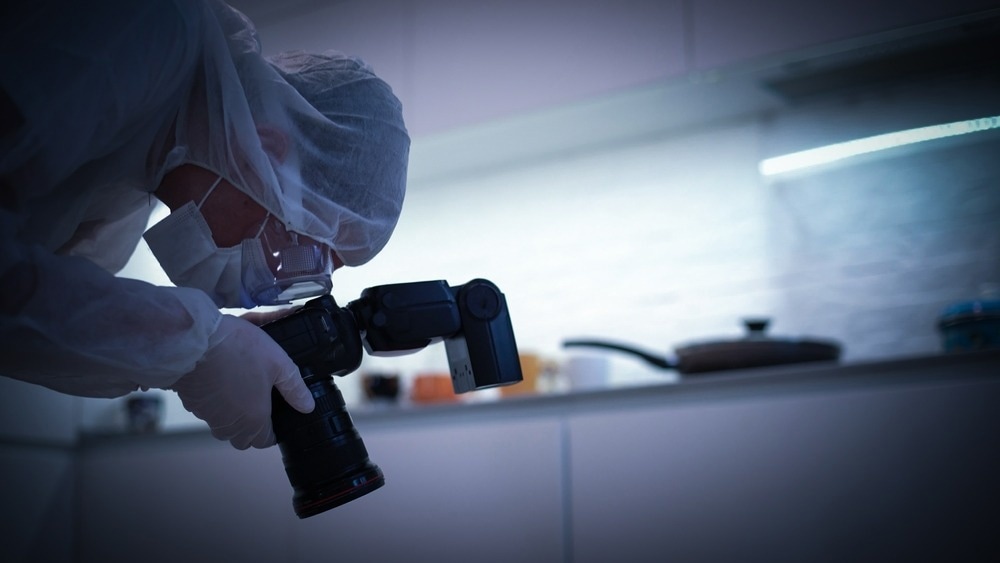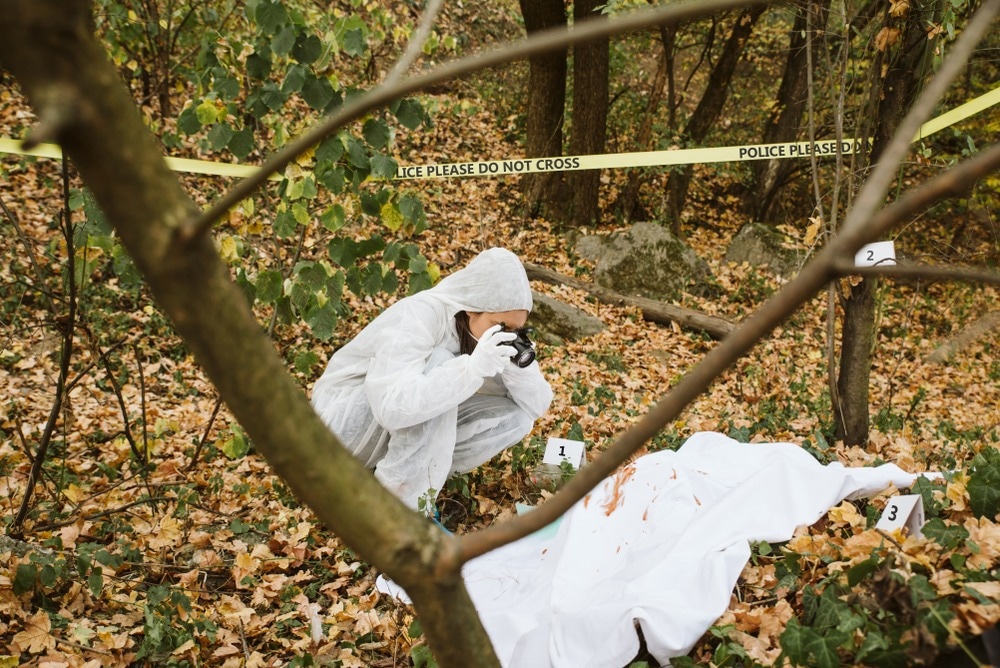Forensic photography is almost as old as the camera itself. It was first implemented in 1851 when a forged document photograph was allowed to be presented as courtroom evidence.

Image Credit: Andrew Angelov/Shutterstock.com
Since then, it has become a forensic investigative tool and a staple for forensic identification and scene analysis. It provides a permanent visual proof of the scene to the forensic investigators, which can be further analyzed by combining it with other techniques. Photography can provide value by measuring an item's precise site and position with respect to other items on the scene, which is something that crime scene sketches cannot accurately capture.
Principles of Forensic Photography
Forensic photographs can record and document the primary state of a crime scene. The required time for photographing a whole crime scene can vary greatly. It is influenced by the size and condition of the crime scene along with certain other complications such as environmental factors and even how much of a health hazard a crime scene poses to the investigating personnel. Therefore, a single crime scene may require thousands of photographs and hours of work.
There are certain principles that should be followed which maximize the information that can be obtained by crime scene photography. The most basic ones are:
- Securing the scene and preventing any rearrangement as it could alter the evidence.
- Evaluation of conditions so that the camera settings can be adjusted accordingly.
- Shooting the scene in its entirety, using wide range shots, and then utilizing close-ups to depict the relation/position of certain items of interest.
- Finally, the victims and the evidence should be photographed, and they both should be highlighted and marked. A scale should also be used when photographing the evidence.
Combination of Photography and other Techniques/Technologies
The latest development of science in merging UV rays and IR with photography has opened up enormous possibilities in criminal investigation without the need for extensive training or costs.
Evidence that is not visible to the naked eye (such as fingermarks and bodily fluids) can be discovered using photography in tandem with forensic light sources. The use of digital cameras provides the added benefit of instantly reviewing their photos and making changes to the camera settings, if needed, to capture the best possible image while still on the scene.
Another instance of combining photography with another technology is unmanned aerial photography (UAV). Previously there were only a few methods to get an aerial photograph - climbing up the ladder or using a manned aircraft, which is highly costly and usually unavailable. UAV requires smaller aircraft or drones, which also allow for capturing close-up photographs. UAV with extended features can transmit photographs to the ground control unit, which can be analyzed and studied by experts in different scientific fields, facilitating the optimal scene examination approach.

Image Credit: ZR10/Shutterstock.com
Using UAVs can minimize the risk forensic examiners face when investigating an unknown crime scene. The contamination of the scene is also reduced when using UAVs which can also be crucial in obtaining the right information from a crime scene. The extent of the scene and finding its entry and exit point can be decided even before setting foot physically on the scene. Overall, using UAVs can offer multifaceted improvements in crime scene management.
The Judicial Aspect and Validity of Photographic Evidence
Although videotaping of crime scenes has become common practice in many jurisdictions; still photography remains the conventional method of presenting optical evidence. Common errors committed during videography of a crime scene include swiveling the camera rapidly, poor focusing and lighting, and improper use of the zoom.
A verbal description of each room and view of the crime scene should be done by the person recording the video while the other investigators and crime scene technicians are silent during the recording.
Correct crime scene photography greatly assists the profiler in developing a psychological and behavioral profile of the perpetrator. Digital imaging tools, such as digital cameras and image processing software, can be important assets to the police department as it gathers and presents evidence to the court.
To ensure that the evidence gathered is valid and will be accepted by the relevant court of law, protocols should be followed to maintain its integrity. If the protocols are not followed religiously, the validity of the documents may be a subject of dispute. Images and digital evidence, in general, must be captured in an unalterable form immediately after the records are created.
A hash value should be created for the digital medium to ensure this. The evidence is kept as soon as the investigation officer procures it, and a copy of this medium should be made available for further examination. This hash value may later be compared with the hash value of the original digital medium to verify that no alterations have been performed after the file was opened at the lab for examination. This way of handling photographic evidence is especially helpful in cases where the alleged accused may have the power to alter digital evidence or even bribe the personnel involved after confiscating the relevant digital evidence.
The agency hired for the case must control the chain of custody of all images and record logs at all times. This requirement ensures someone can testify about who had access to any image used to support testimony as evidence. Using unalterable media for storage and a separately managed index for each unit can fortify the integrity of information in the court.
Closing Remarks
Forensic photography plays an enormous role throughout the entire investigation by creating stable visual proof of the crime scene and evidence found in the original state. It reconstructs the events that transpired at the crime scene while giving a clear image to the jurors in the courtroom. Earlier photographs were not considered as evidence but as a source to give a visual record of the crime scene and the location of the evidence within the scene. Forensic photographs will continue to be a staple in crime scene investigations and will gradually become even more useful with technological advancements.
Further Reading